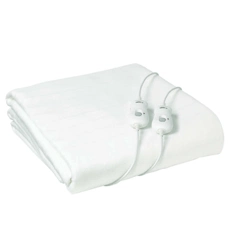Loading ...
Loading ...
Loading ...

1110
Before first use
Before using your electric blanket for the first
time, Sunbeam recommends that you switch
the blanket to maximum heat (setting 9) for
two to three hours to evaporate any moisture
in the mattress. Repeat this process every
few months to maintain a dry, healthy bed.
Your electric blanket control has nine heat
settings, which are recommended for use as
follows:
1-3 Low, gentle heat for all night use
4-6 Medium heat
7-9 High heat, for preheating only
Use the high heat settings to preheat your
bed only. Do not sleep with your blanket on
these settings for more than 30 minutes.
Using your 9 heat control with timer
Your timer control features a slide switch to
select the desired operating mode, plus an
easy to use dial to select the temperature
setting (see Figure 6). The heat setting dial is
illuminated for easy adjustment in the dark.
75 minute setting
Use the 75 minute setting to preheat your
bed before hopping in. Move the slide switch
to the 75min position. The temperature dial
will then illuminate enabling you to turn
the dial to your desired heat setting. The
timer indicator light (positioned next to the
slide switch) will go out, indicating that the
blanket is on and heating.
Your electric blanket will automatically switch
off after 75 minutes. The timer indicator
light will illuminate and the light in the
temperature dial will go out, indicating that
the timer period has elapsed and the blanket
is no longer heating.
To restart the timer, move the slide switch
to the OFF position and then return it to the
desired timer position.
12 hour setting
Ideal for colder nights or those who like
warmth all through the night, the 12 hour
setting automatically switches your electric
blanket off after 12 hours. Move the
slide switch to the 12 hour position. The
temperature dial will then illuminate enabling
you to turn the dial to your desired heat
setting. The timer indicator light (positioned
next to the side switch) will go out, indicating
that the blanket is on and heating. Sunbeam
recommends that you use only settings 1, 2
or 3 for all night use.
Your electric blanket will automatically
switch off after 12 hours. At the end of the
timer period, the timer indicator light will
illuminate and the light in the temperature
dial will go out, indicating that the timer
period has elapsed and the blanket is no
longer heating.
To restart the timer, move the slide switch
to the OFF position and then return it to the
desired timer position.
Using your 6 heat digital timer control
Ensure that the control is connected to the
blanket properly. Move the slide switch on
the rear of the control to the on position (I).
The blue standby light (
) will illuminate to
indicate that the blanket is connected to the
power outlet but is not heating.
Press the timer button (
) to turn the
control on. Heat setting 1 will illuminate.
Select the desired temperature using the
temperature (
) button. The selected
temperature setting will illuminate. Pressing
the temperature button cycles through the
various temperature settings, from 1 through
to 6, then back to 1.
Sunbeam recommends that you use only
settings 1-5 for all night use. Use setting 6
for fast preheating only.
To change the timer period, press the timer
button (
). Pressing the timer button will
cycle through the two timer options, 1 hour
or 9 hours, and standby mode. If the timer
setting is changed during the timer period,
the timer will restart.
At the end of the selected timer period, the
blanket will switch off and the blue standby
light will illuminate. To switch the blanket
on again, press the timer button to select a
timer period. The control will default to the
previous temperature setting. You can adjust
the temperature at any time during the timer
period.
Using your electric blanket Using your electric blanket
Figure 6.
Figure 6.
Loading ...
Loading ...
Loading ...
